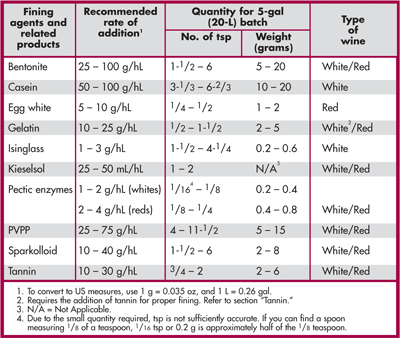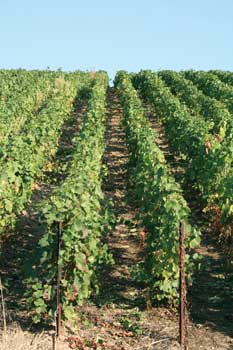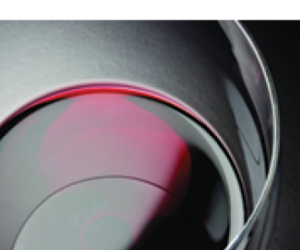 Pesky cloudy wines!
Pesky cloudy wines!
Sediments in the bottle! There is nothing more frustrating to home winemakers than a wine that will not clear or that continues to throw sediments in the bottle.
Making crystal-clear wine is an important objective in any type of winemaking. Anything less is considered a serious wine fault — a telltale sign of poor winemaking control — and will probably be shunned by serious wine drinkers.
A seemingly clear wine can also throw sediments in the bottle. This is usually not considered a wine fault in older wines that have been aged for many years and that have not been clarified except for periodical rackings. However, sediments in early-drinking, young wines are a sign of insufficient clarification and rushed winemaking.
Grape juice and wine contain many naturally occurring particles as well as compounds acquired during winemaking, such as tannins during oak barrel aging, which will affect clarity and may result in sediments in the bottle. Proteins, pectins, phenols (such as color pigments, tannins) and salts are examples of such particles that need to be controlled through racking, use of natural additives (fining agents), and careful filtration.
Note: Clear (tartrate) crystal deposits at the bottom of a bottle or on the inside end of the cork are a result of the wine being subjected to cold temperatures. Tartrate crystals are a different beast altogether and should not be confused with other sorts of sediment. Tartaric acid, the most prominent wine acid, will cause some precipitation under cold temperatures; it is not a problem related to clarification. Cold stabilizing the wine prior to bottling prevents tartrate deposits. (Refer to “Fix Your Wine!” in the Winter 2001 issue of WineMaker for more information on cold stabilization.)

Many traditional commercial winemakers, many of whom produce some of the best wines in the world, avoid the use of additives or filtration to clarify wine for fear that it might be perceived as unnatural winemaking. These winemakers prefer to rely instead on periodical rackings — for example, they might rack every 3 months over a period of 18–24 months.
Home winemakers wanting to produce early-drinking wines without the hassle of multiple rackings or having to age wine should always clarify wine using fining agents and/or filtration. In this article, we will examine fining agents available to home winemakers, and explain how to maximize their effectiveness in clarifying wines.
Selecting and using fining agents
Early-drinking wines from fresh juice or grapes should always be clarified prior to bottling. The high-protein content in these wines can cause clarity instability, resulting in a cloudy wine or sediments in the bottle. Wines from concentrate or other processed juice (such as semi-concentrate or sterilized juice) are designed for quick production and bottling and therefore should also be clarified.
When selecting a fining agent, the main factors to consider are the type of wine you are making (white or red), the tannin concentration of the wine, and desired results relative to color.
Fining agents have varying levels of effectiveness in white versus red wines because of different particles present, namely concentration of phenolic compounds. Tannin concentration is the most significant difference in the context of clarification and may cause improper clarification with some fining agents, resulting in a cloudy wine or bottle sedimentation. Grapes and the process used in red winemaking impart a higher concentration of phenolic compounds. As a result, red wines have a significantly higher tannin content compared to white wines. Wines aged in oak barrels will also have higher tannin content because oak is rich in tannin.
The primary objective of clarification using fining agents is to produce a clear wine, free of suspended particles that could otherwise affect clarity. Color should be altered only minimally, except in the case where color must be corrected from such problems as browning due to oxidation. Great care must be taken with some fining agents to avoid over-fining, which would strip color compounds from the wine.
The table above lists common, commercially available fining agents for clarifying white and red wines, along with the recommended rate of addition and the type of wine where it is most effective, and other products used to improve the effectiveness of fining agents. Always start with the lowest rate of addition in the recommended ranges, and increase the rate, as required, if the wine requires further clarification.
Fining agents in solid form should always be dissolved in water first, unless specified otherwise, according to instructions before adding to wine. Fining agents lose their effectiveness if dissolved or introduced directly into the wine.
Bentonite
Bentonite is a natural absorptive clay that binds to and precipitates oppositely charged suspended particles. It is used in clarifying both red and white wines, although it is highly recommended for white wine applications because it inhibits haze caused by naturally occurring proteins in juice. Bentonite’s clarifying effectiveness makes it a popular choice as a fining agent among winemakers, although the heavy deposit translates into more wine loss. One of its advantages over other fining agents is that it minimizes color reduction and therefore provides a safeguard against over-fining.
Bentonite is added at a rate of 25–100 g/hL of wine. First, prepare a bentonite solution by adding the required amount of powder to a volume of warm water approximately 15 times the weight of the powder, e.g., 20 g in 300 mL. Shake the solution vigorously for a few minutes, and then let stand for 24 hours while shaking or stirring occasionally. Add to the wine while stirring continuously, and store the wine at a temperature between 59° and 77° F (15° and 25° C) for approximately one week before racking.
Bentonite is most effective when added at the end of fermentation, although it can be added prior to start of fermentation to help the clarification process. Double the rate of addition without exceeding the recommended maximum when adding bentonite before start of fermentation.
Casein
Casein, a phosphoprotein of milk that flocculates to absorb and precipitate suspended particles, is primarily recommended for clarifying white wines, especially for reducing tannin content in over-oaked white wines, and for reducing browning resulting from oxidation. Drawbacks include color stripping if excessive casein is used, and requires a second fining with bentonite to avoid clogging of filter pads if the wine is to be filtered.
Casein powder is added at a rate of 50–100 g/hL of wine. Dissolve the powder in a small volume of water — use 100 mL of water for each gram of casein powder — and then quickly add the solution to the wine while stirring vigorously. To avoid over-fining, use the lowest rate of addition and increase if the wine was aged in oak barrels. Rack the wine after a couple of days or within one week. For white wines affected by browning due to oxidation, increase the rate of addition to the maximum depending on the severity of the oxidation problem.
Egg white
Egg white is a very effective fining agent, long used for clarifying red wines and still widely used in modern winemaking. The rich albumen content in egg white makes it ideal for softening a wine’s astringency by binding and reducing the tannin content, and is therefore most appropriate for highly tannic wines or oak-aged wines. Although there is a small risk of over-fining, color loss in the wine is minimal when fining and racking are properly controlled.
Egg whites are added at a rate of 5–10 g/hL of wine, or the white of 1 to 2 eggs per 100 L; be sure to first separate the egg white from the yolk. Alternatively, pure, refrigerated egg white can be used. Typically, approximately 30 mL (6 tsp) of pure egg white is the equivalent of 1 large egg white. Next, prepare a saline solution by dissolving a pinch of salt in 10 mL of water for each egg used, and stir gently into the egg white. Salt is added to prevent the solution from getting cloudy. Add the saline egg-white solution directly into the wine and stir vigorously. Rack the wine within 1–2 weeks, no later.
Gelatin
Gelatin, derived from animal tissues, is a good fining agent for red wines because of its affinity for binding with phenols in precipitating suspended particles and for reducing tannin content. For this reason, it is usually not recommended for fining white wines, as it will reduce the small amount of tannins — and, in fact, it may not fine adequately if the tannin content is too low. To avoid over-fining in white wines, tannin powder can be added before gelatin fining.
Gelatin crystals are added at a rate of 10–25 g/hL of wine. Use the maximum rate for highly tannic wines or wines having a higher-than-normal concentration of suspended particles or pectin. Prepare a gelatin solution by soaking unflavored gelatin crystals in approximately 25 times its weight of warm water. For example, if 10 g/hL of gelatin is desired in 20 L of wine, then dissolve 2 g of gelatin in 50 mL of warm water. Stir the gelatin thoroughly until dissolved completely. Some gelatin manufacturers may recommend soaking the gelatin in cold water and then heating it until it just starts boiling. Always follow the manufacturer’s instructions for the gelatin product you purchase.
Mix the warm gelatin solution with a little wine — about twice the amount of water used — and then add it to the rest of the wine while stirring. Rack the wine within 2–3 weeks.
Isinglass
Isinglass, a very pure gelatin prepared from the air bladders of sturgeons, is a popular fining agent among home winemakers because it strips color to a lesser extent than other protein-based fining agents, such as gelatin or casein. It is most effective in clarifying white wines, particularly oak-aged whites. A drawback is that it throws a heavier deposit that tends to cling to the carboy glass wall, making racking a little tricky. A second fining with bentonite alleviates this problem and avoids clogging of filter pads if the wine is to be filtered.
Isinglass powder is added at a rate of 1–3 g/hL of wine by first dissolving it in water at a temperature between 61° and 64° F (16° and 18° C) and stirring the solution thoroughly. Let the solution stand for 15 minutes, stir once again for 2 minutes, and then add it to the wine while stirring vigorously. Rack the wine within 1–2 weeks.
Isinglass is also sold as a solution for convenient mixing into wine. You can find this solution at many winemaking shops. Follow the manufacturer’s recommended rate of addition.
Kieselsol
Kieselsol, a silicate suspension that electrostatically binds to and precipitates proteins, is an excellent fining agent for both white and red wines and is specifically effective in wines with low tannin content. Kieselsol is therefore recommended for wines produced from concentrate, sterilized or fresh juice, or wines that have not been oak-aged in barrels. Use kieselsol in conjunction with gelatin to increase its effectiveness.
Kieselsol is added at a rate of 25–50 mL/hL of wine. Add the kieselsol suspension directly into the wine, and stir gently. After 24 hours, add gelatin at the recommended rate and rack the wine within 1–2 weeks.
Pectic enzymes
Pectic enzymes are not classified as fining agents, but they greatly improve fining and filtering operations of high-pectin wines by breaking down pectins, which occur naturally in wines but are often the cause of cloudiness. Pectic enzymes are especially beneficial for press-run wines (from grapes), as well as fruit and country wines, because these tend to have much higher pectin content.
Pectic enzyme powder is added at a rate of 1–2 g/hL for white wine and 2–4 g/hL for red wine by first dissolving the powder in cool water. It is recommended to add pectic enzymes following the crushing operation (for wines produced from grapes), as a preventive additive, although they can be added during the fining operation. The juice or wine should be at a minimum temperature of 80° F (27° C) for pectic enzymes to be effective.
If cloudiness persists after fining, this indicates that the wine may contain excessive pectin. To test for the presence of pectin, add 50 mL of wine to 200 mL of methanol. If heavy, whitish sediments form, the wine contains excessive pectin and should be treated again with pectic enzymes.
Filtering is recommended for wine treated with pectic enzymes to further clarify the wine.
Pvpp
PVPP, short for polyvinylpolypyrolidone, is a synthetic polymer that is effective in absorbing and precipitating polyphenols, responsible for browning in wines as well as excessive bitterness in red wines. PVPP is typically used as a preventive fining agent to avoid such problems.
PVPP powder is added directly to wine at a rate of 25–75 g/hL of wine. Settling occurs very fast, as fast as 1–2 hours, depending on the type of PVPP used. Rack the wine immediately after settling, and filter the wine.
Note: There are different PVPP formulations requiring different rates of addition and shorter or longer settling periods. The above instructions are provided as guidelines; be sure to follow the manufacturer’s instructions for the PVPP product you purchase.
Sparkolloid
Sparkolloid, a proprietary fining agent derived from alginic acid salt found in brown algae, is very effective in settling finely suspended particles and is therefore recommended for red wines, although it is suitable for white wines also. A benefit of Sparkolloid’s effectiveness is increased filter throughput, if the wine is to be filtered, due to the greater extent of lees compactness.
Sparkolloid powder is added at a rate of 10–40 g/hL of wine. First prepare a Sparkolloid solution by boiling water in a saucepan. Add the Sparkolloid powder to the boiling water and stir thoroughly. Let the solution boil for 20 minutes while stirring continuously to dissolve all the powder. Add the hot Sparkolloid solution to the wine while stirring continuously.
Although many winemakers recommend letting the wine settle for only a week or two before racking, experience has shown that settling can occur well after bottling. I recommend letting the wine clarify for approximately 3–6 months before racking, particularly when using a rate of addition at the upper end of the range.
Tannin
Tannin is a key oenological ingredient contributing to a wine’s structure and taste, and a key component of age-worthy wines. Tannins are extracted mainly from grape skins during the maceration process in red winemaking, or from oak wood during barrel aging of whites and reds. The lesser-known application of tannin is in the fining operation. Although tannin is not classified as a fining agent, clarification is often dependent on the presence of tannins, and requires to be added (in the form of oak bark powder, for example) for fining agents such as gelatin to be effective.
For fining low-tannin wines with gelatin, tannin powder is added at a rate of 10–30 g/hL of wine. Prepare a tannin solution by dissolving the powder in warm wine and then add it directly to the wine batch, 3–5 days before adding the fining agent. Stir the solution in thoroughly.
Conduct bench tests
It is always recommended to perform bench tests if you are not familiar with fining agents. Fining can be quite a complex science for the uninitiated. Fining agent effectiveness depends on the rate of addition, pH and composition of the wine (e.g., acids, proteins, phenols), temperature, and other factors that can influence results. In addition, fining agents have varying levels of effect on color, aromas and flavors. So always perform bench tests and learn from your tests and experience.







